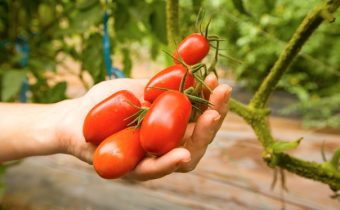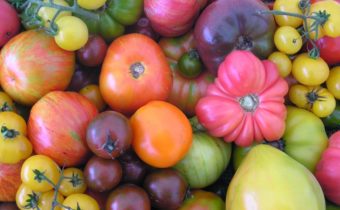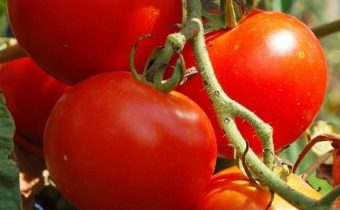Tomatoes in bags: features of the method
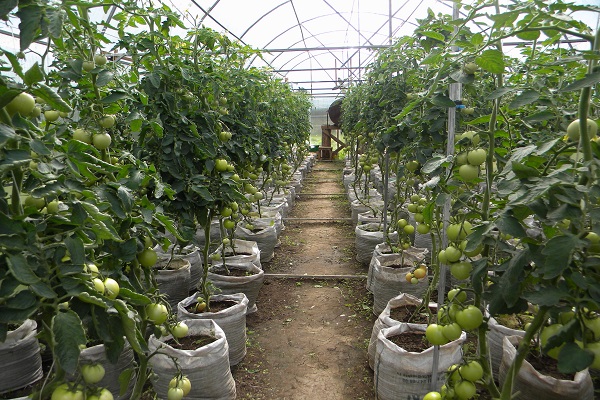
Recently, new and original ones have been added to the usual methods of planting tomatoes. One of these methods is growing tomatoes in bags. Every day, fans of the exotic way is becoming more and more. Attracts summer residents simple technology and high efficiency.
Technology
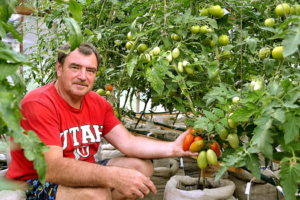
The original method of growing tomatoes is to plant the plants in separate bags filled with nutritious soil. "Tomatoes in bags" can be cultivated in the open field and in the greenhouse.
For this you will need:
- bags (with the calculation of one bag for 1-3 plants depending on the volume and variety);
- nutrient soil;
- support devices (pegs, twine, wire);
- seedlings.
The most suitable are plastic bags with a volume of from 30 to 75 liters. One plant is planted in small-sized containers, two bushes will fit well in a sixty-liter bag, and three in a 75-liter bag. The denser the fabric, the less risk that the bottom will break. The best option are bags of sugar. Such packaging will be durable and will last more than one season. Plus, the woven structure of the burlap will not allow water to stagnate. Access of oxygen to the roots in such containers is also provided.
Tara can be purchased at any large shopping center in the garden department. When buying, stop your choice on white bags. So the sun will burn less, which means the roots will be protected from overheating.
Nutritious soil can be prepared on its own or purchase ready-made composition. Purchased soil specifically for tomatoes is ready for planting and does not require additional procedures. In order to save the soil mixture can be prepared at home. To do this, mix in equal parts the following ingredients:
- humus;
- garden or forest land;
- wood ash (1 liter per 20 liters of soil);
- superphosphate (20 grams per 20 liters of soil).
Seedlings for this method are grown in the usual way. It is possible to sow seeds for 10-14 days ahead of time recommended by the producer.
In order for the result to meet expectations, it is important to choose the right variety of tomatoes. According to agricultural technicians, the most suitable for greenhouses are:
- "Tretyakovsky";
- Brutus;
- "Grandmother's basket".
For cultivation in open ground are suitable:
- "June";
- Energo;
- "Turbojet";
- "Destructive force".
Experienced vegetable growers believe that all stunted and medium-grown tomatoes can be grown in bags.
Landing procedure
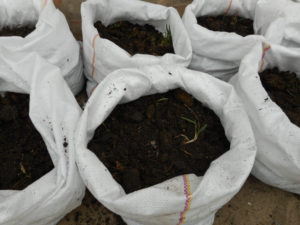
Planting tomato seedlings is carried out according to the following algorithm:
- Small drainage holes are made in the lower and side parts of the bag.
- Bags filled with nutrient primer for 2/3.
- The upper free part of the burlap tuck.
- Depending on the volume of the bag, one, two or three plants are planted.
- The soil is plentifully shed with warm settled water.
- Tomatoes are tied to a support.
- Bags are placed in open ground in a convenient place or moved to a greenhouse.
Care
Caring for tomatoes "in bags" is simple and consists of simple agrotechnical methods: watering, feeding and forming a bush.
Watering and feeding
When growing tomatoes in such an unusual way, the usual rule is: “watering is rare but abundant” does not work.Watering plants need as needed. Since the volume of the soil is limited there is a risk of drying out of the soil, which means the roots of the seedlings. At moderate air temperatures, tomatoes irrigate 2-3 times a week. During hot periods, the soil is moistened every other day.
The frequency of dressings is determined by the condition of the soil and the variety of tomatoes. So if the soil for planting was well filled, then the first dressing can be postponed until the period of bud formation. During this period, fertilizers with a complex composition will be effective. When planting in poor soil, seedlings can be fed in two weeks. Tomatoes with a long fruiting period need additional feeding after harvesting the first wave of the crop.
Tomatoes should be watered with warm, settled water in the early morning or in the evening, after sunset. To reduce the risks of disease watering the bushes is necessary only at the root, avoiding water on the stems and leaves.
Formation and tying tomato bushes
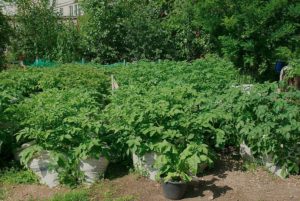
To engage in the formation of bushes need to begin as early as two weeks after transplanting plants into the bags. Usually at this time new shoots (stepchildren) are beginning to form, which, depending on the variety, should be removed or left to grow. As a rule, tomatoes are in one or two stems, with the exception of short-growing varieties that do not require stading. It is best to familiarize yourself with the recommendations of the variety originator and try to follow them.
Regardless of where the “vegetable bed” is located in the greenhouse or in the open ground, the plants must be tied up. This can be done in two ways:
- put wooden pegs in each bag and tie bushes to them;
- pull over the rowed tomatoes with a lath or thick wire, to which the plants are tied up with a string.
The first method is used by vegetable growers more often, since, if necessary, tomatoes can be transferred to another place without any problems.
General recommendations for growing tomatoes in bags
- in order to prevent pests from getting into the bags, they can be installed on pallets or bricks;
- in the dense burlap, make drainage holes in the bottom area, this will prevent water stagnation;
- Do not plant tomatoes too often, this may lead to a shortage of sunlight and trace elements;
- arrange the tomatoes in bags in a sunny place, then the vegetables will be fragrant and sweeter;
- plant varieties with different ripening periods to harvest throughout the season;
- if it is not possible to water the tomatoes often, add vermiculite to the soil. It will improve the structure of the soil and retain moisture.
Pros and cons of the method
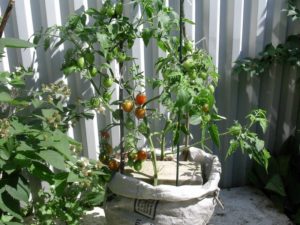
The method in question has the following advantages:
- bags can be placed in a convenient place and moved if necessary;
- during a cold snap, “vegetable beds” can be transferred to a warm room;
- due to the rapid heating of the soil, the crop ripens one or two weeks earlier;
- ease of care (no need to dig, weed weeds);
- nutrients and water flow directly to the roots, so the yield is good;
- the risk of fungal infections is minimal (tomatoes are high off the ground and well ventilated).
Gardeners point out the following disadvantages of the method:
- bags can break in the bottom area;
- not everyone can move filled containers with tomatoes.
In order for the bags to last not one season, do not save on the quality of the goods, choose a burlap of increased density.
Reviews
Marina, Nizhny Novgorod region
For the first time this year I tried such an exotic method. Planted in a small bag of sugar (10 kg) tomatoes "Room surprise". As the soil used humus. The result must be said pleased. Compact bushes looked great in small bags. I planted two plants in one bag. Tomatoes are small, but there were a lot of them. Next year I want to try to plant different varieties in bigger bags.
Yevgeny, Chelyabinsk
My first experience with growing tomatoes in bags was unsuccessful. As a container, I used large plastic bags. The filled bags turned out to be too “thin” and unstable. I had to prikopat them a bit with earth and press them with bricks, but during the season I constantly corrected them. It certainly did not affect the yield. Tomatoes turned red on the bushes.
Planting tomatoes in bags as well as caring for them is not a difficult procedure. This method is suitable for owners of marshy, lowland and small areas.


 (10 ratings, average: 4,80 from 5)
(10 ratings, average: 4,80 from 5)
